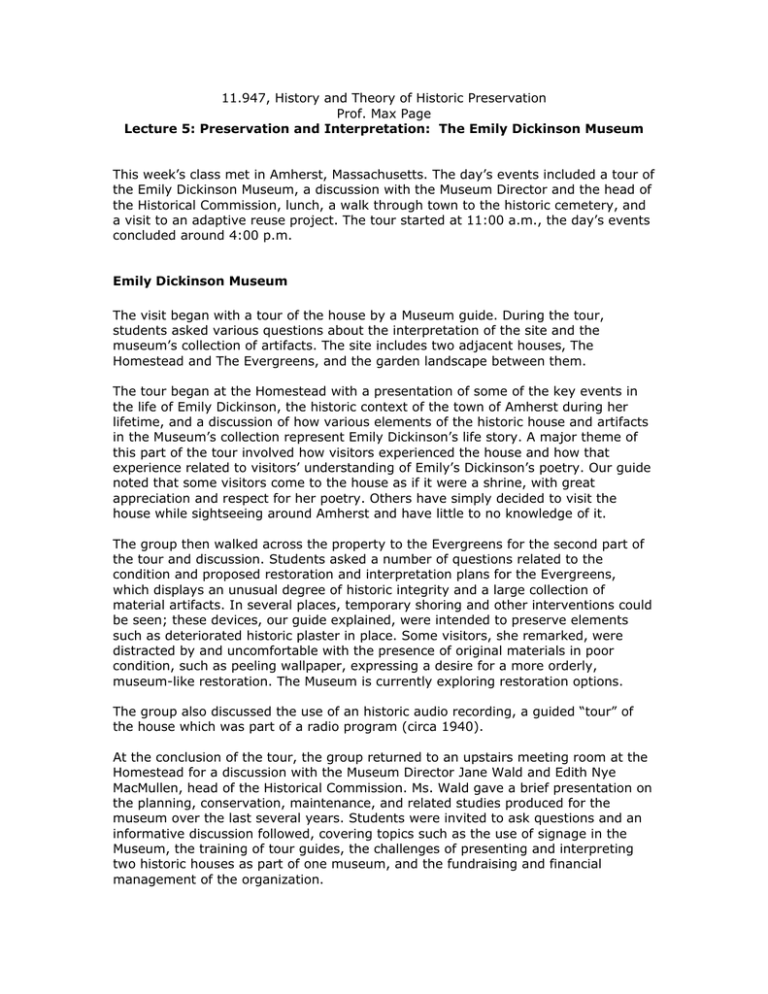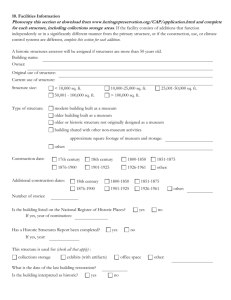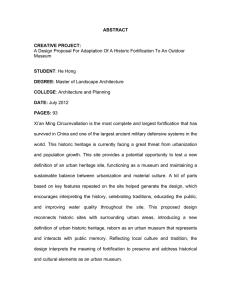11.947, History and Theory of Historic Preservation Prof. Max Page
advertisement

11.947, History and Theory of Historic Preservation Prof. Max Page Lecture 5: Preservation and Interpretation: The Emily Dickinson Museum This week’s class met in Amherst, Massachusetts. The day’s events included a tour of the Emily Dickinson Museum, a discussion with the Museum Director and the head of the Historical Commission, lunch, a walk through town to the historic cemetery, and a visit to an adaptive reuse project. The tour started at 11:00 a.m., the day’s events concluded around 4:00 p.m. Emily Dickinson Museum The visit began with a tour of the house by a Museum guide. During the tour, students asked various questions about the interpretation of the site and the museum’s collection of artifacts. The site includes two adjacent houses, The Homestead and The Evergreens, and the garden landscape between them. The tour began at the Homestead with a presentation of some of the key events in the life of Emily Dickinson, the historic context of the town of Amherst during her lifetime, and a discussion of how various elements of the historic house and artifacts in the Museum’s collection represent Emily Dickinson’s life story. A major theme of this part of the tour involved how visitors experienced the house and how that experience related to visitors’ understanding of Emily’s Dickinson’s poetry. Our guide noted that some visitors come to the house as if it were a shrine, with great appreciation and respect for her poetry. Others have simply decided to visit the house while sightseeing around Amherst and have little to no knowledge of it. The group then walked across the property to the Evergreens for the second part of the tour and discussion. Students asked a number of questions related to the condition and proposed restoration and interpretation plans for the Evergreens, which displays an unusual degree of historic integrity and a large collection of material artifacts. In several places, temporary shoring and other interventions could be seen; these devices, our guide explained, were intended to preserve elements such as deteriorated historic plaster in place. Some visitors, she remarked, were distracted by and uncomfortable with the presence of original materials in poor condition, such as peeling wallpaper, expressing a desire for a more orderly, museum-like restoration. The Museum is currently exploring restoration options. The group also discussed the use of an historic audio recording, a guided “tour” of the house which was part of a radio program (circa 1940). At the conclusion of the tour, the group returned to an upstairs meeting room at the Homestead for a discussion with the Museum Director Jane Wald and Edith Nye MacMullen, head of the Historical Commission. Ms. Wald gave a brief presentation on the planning, conservation, maintenance, and related studies produced for the museum over the last several years. Students were invited to ask questions and an informative discussion followed, covering topics such as the use of signage in the Museum, the training of tour guides, the challenges of presenting and interpreting two historic houses as part of one museum, and the fundraising and financial management of the organization. For more information on the Emily Dickinson Museum, see the Museum’s official website: http://www.emilydickinsonmuseum.org/ Amherst Cemetery Mural After lunch, the class made a trip to the Amherst cemetery to see a new mural depicting historic themes and personages in the town’s development. The group also stopped at the Dickinson family gravesite. The mural has been painted on the back of a commercial building immediately adjacent to the cemetery. The class discussed the role of public art in the interpretation of historic sites. To view a detailed photograph of the mural, see muralist David Fichter’s website: http://davidfichter.net/images/l/amherstComm1.jpg Adaptive Reuse: Amherst Cinema (Offices of Kuhn Riddle, Architects) The final stop on the tour was the former Amherst Cinema, a large, brick, shed-like structure near the center of town. A comprehensive, multi-million dollar adaptive reuse of this building, formerly used as stables, a car dealership, and a movie theater, was recently completed. An architect from the offices of Kuhn Riddle gave a tour and a description of the design decisions made in executing this complex development project. For more information, see the photos and renderings of the project at the Amherst Cinema website: http://www.amherstcinema.org/gallery/index.php 11.947, Historic Preservation Prof. Max Page Lecture 5 Page 2 of 2



